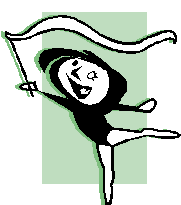Main
Menu
Introduction
Dance Analysis
Section 1
Section 2
Section 3
Section 4 Management
Suggestions
Assessment Strategy
Teacher Reflections
Dr Hopper Website
|
|
Teacher
Lessons and Reflections
by Rebecca and Lindsay
Lesson Plans
Lesson 1
Lesson 2
Lesson 3
Lesson 4
Lesson 5
Working
Collaboratively
- We found it
very useful working cooperatively to plan this unit and website. We
had fun coming up with an imagery idea to shape our dance around.
- We recommend
collaborative planning to bring new ideas to the unit, the other person may
have ideas that you have not previously thought of.
- Teaching our
peers helped give us a better idea of to refine the dance to best teach to
our movement sequence to elementary students.
- Feedback from
our peers and our own reflection of our peer teaching reminded us of the
importance of keeping in mind length of gym classes in elementary schools,
so the length of our dance was also an area that had to be refined.
Moving in Space
- We found
that students needed reminders for staying in own personal space and away
from the walls. Even though students have had previous experience in
this area, friendly reminders are always necessary.
- Constantly
giving feedback on students' use of personal space, such as recognizing
those students that are working hard to stay in their own space, encouraged
students to move safely throughout the gym.
- If you are
lucky enough to have a gym to work in it is important to remind students to
use all of the available space. This allows for more creative
movements!
Pacing the Lessons
-
In the first
lesson we focused on exploring personal space and moving to a steady beat.
We realized the students needed more time to explore their own movements
before focusing on specific actions words.
-
From this point
on, we focused on exploring action words such as peek, creep, and skip,
etc... using instruments and the music to guide the movements. Since
we taught in half hour gym times, it took more time than expect, therefore,
not much time was spent practicing music to the music.
-
Students can then
explore creating their own ending for the final lesson while incorporating
the elements of creative movement they have learned previously. This
is a fun idea, but due to time constraints we did not get the chance to
develop this part of the dance.
Introducing the Picture
- When we
introduced the picture throughout the lessons. The students were very
enthusiastic and contributed lots of ideas of what they might be and how
they might move. This was definitely a motivational aspect for the
dance and we recommend using an picture to develop the imagery for other
creative movements.
- Using the
picture helped students further explore levels and pathways. When we
asked students what they could be hiding behind, many students used ideas
from the picture and their exploration with levels resulted from this.
- Enlarging the
picture or displaying it on an overhead is most effective.
Putting It All
Together
These are some of the strategies that we found
most effective in putting the dance to a steady a beat and to the music:
- finger dancing
- listening to the cues in
music (raising your hand when you hear a change in the music)
- use of a variety of
instruments that match the imagery of the dance and keep the steady beat
- Teacher cues (calling out
beats and sections of the dance)
Creating your own
ending
-
Creating
your own ending can be a fun way for kids to use what they have learned
previously while adding their own creative element. We found that it is
beneficial to give some prompting to stimulate students' thinking about how
they want to complete their ending. We used the Harris Burdick picture
as well as the music to extend the students creativity.
-
Giving
students the opportunity to explore creating their own ending can be a fun
experience for the students but it can be time consuming and you need to
allow time for the students to explore and play around with ideas. We were
unable to get to this point with our students but from our observations of
their learning, we think that they would have enjoyed this part of the
dance.
Inclusion
-
There was one boy in our
class that was Autistic and we soon realized that there were some things
that he was not as willing to take part in, such as skipping. Even
though he didn't participate in all aspects of our movement sequence he was
still excited to be a part of the class. We think that it is very important
to refine tasks so that all members of the class are able to participate at
some level.
|

